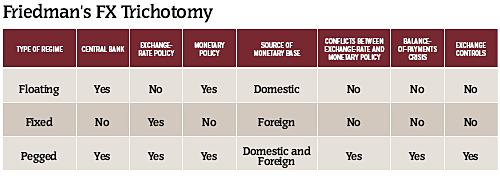
With the passing of Milton Friedman last November, we lost one of the great champions of free markets. Friedman’s obituaries and commentaries on his life’s work and enormous influence have invariably mentioned his advocacy of floating exchange rates, leaving the impression that he always favored floating rates. This was not the case.
For Friedman, there were three distinct types of exchange-rate regimes: floating, fixed, and pegged (see accompanying table), each with different characteristics and different results.
Although floating and fixed rates appear dissimilar, they are members of the same free-market family. Both operate without exchange controls and are free-market mechanisms for balance-of-payments adjustments. With a floating rate, a central bank sets a monetary policy but has no exchange-rate policy—the exchange rate is on autopilot. In consequence, the monetary base is determined domestically by a central bank. With a fixed rate, there are two possibilities: either a currency board sets the exchange rate, but has no monetary policy—the money supply is on autopilot—or a country is “dollarized” and uses a foreign currency as its own. In consequence, under a fixed-rate regime, a country’s monetary base is determined by the balance of payments, moving in a one-to-one correspondence with changes in its foreign reserves. With both of these free-market, exchange-rate mechanisms, there cannot be conflicts between monetary and exchangerate policies, and balance-of-payments crises cannot rear their ugly heads. Indeed, under floating- and fixed-rate regimes, market forces act to automatically rebalance financial flows and avert balance-of-payments crises.

Fixed and pegged rates appear to be the same. However, they are fundamentally different: pegged-rate systems often employ exchange controls and are not free-market mechanisms for international balance-of-payments adjustments. Pegged rates require a central bank to manage both the exchange rate and monetary policy. With a pegged rate, the monetary base contains both domestic and foreign components. Unlike floating and fixed rates, pegged rates invariably result in conflicts between monetary and exchange-rate policies. For example, when capital inflows become “excessive” under a pegged system, a central bank often attempts to sterilize the ensuing increase in the foreign component of the monetary base by selling bonds, reducing the domestic component of the base. And when outflows become “excessive,” a central bank attempts to offset the decrease in the foreign component of the base by buying bonds, increasing the domestic component of the monetary base. Balanceof- payments crises erupt as a central bank begins to offset more and more of the reduction in the foreign component of the monetary base with domestically created base money. When this occurs, it is only a matter of time before currency speculators spot the contradictions between exchange-rate and monetary policies (as they did in the Asian financial crisis of 1997-98) and force a devaluation or the imposition of exchange controls.
There was more to Friedman than floating exchange rates, much more. His exchange-rate trichotomy makes this clear. As a matter of principle, Friedman favored both floating and fixed rates. Capital flows freely, without controls, under these two free-market regimes. Friedman always rejected the pegged exchange-rate regime.
Friedman’s actions—and he was a man of action—also demonstrate that his arsenal contained more than floating rates. In 1992, I co-authored a book, Monetary Reform for a Free Estonia, which carries the following dust jacket endorsement by Friedman: “A currency board such as that proposed by Hanke, Jonung and Schuler is an excellent system for a country in Estonia’s position.” Within six months, Estonia had dumped the Russian ruble and its currency board was exchanging kroon at a fixed rate of eight per German mark (subsequently 15.65 per euro). Since then, Estonia’s GDP per capita has increased tenfold, a spectacular performance.
During the Asian crisis of 1997-98, Friedman again entered the fray. As former President Suharto’s advisor, I proposed that the rupiah be fixed to the dollar via a currency board. Shortly thereafter,The Far Eastern Economic Review published “The Sayings of Chairman Milton.” His thoughts on a currency board for Indonesia were: “If the Indonesians would live by the discipline, it could be a good thing. What else can they do?” Well, they could be forced by a U.S.-IMF lead phalanx to abandon the currency board idea, which is just what happened—with disastrous economic results.
Where did Friedman stand with regard to the world’s showcase free-market economy? He favored Hong Kong’s fixed exchange rate: “The experience of Hong Kong clearly indicates that a particular country like Hong Kong does not need a central bank. Indeed it has been very fortunate that it has not had one. The currency board system that was introduced in 1983 has worked very well for HK and I believe it is desirable that it be continued.” Contrary to popular belief, Milton Friedman favored both floating and fixed exchange rate regimes.
Author Steve H. Hanke

0 responses on "Friedman on FX Regimes"